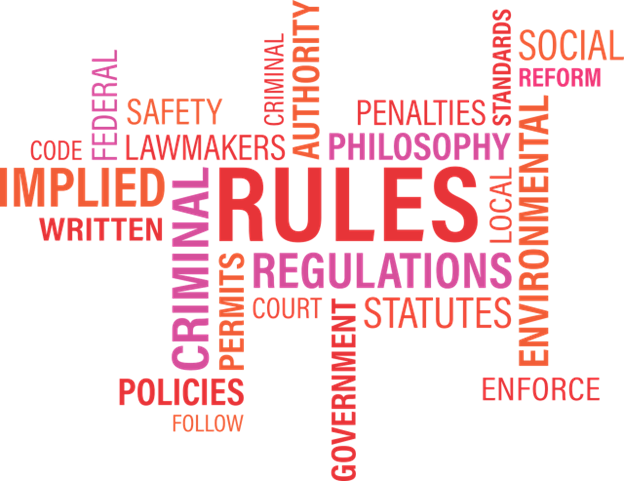For many years, conservatives and “free market” economists have complained about the ever-expanding “Administrative State.” At the same time, those on the left have relied more and more on bureaucrats at various federal agencies to issue more and more regulations and restrictions on a variety of private industries, including oil refining, gas production, agriculture, and even fishing, usually in the name of increased safety or to control prices.
Since the early 1980’s, one tool used by a variety of government agencies responsible for the ever-expanding web of regulations is the US Supreme Court decision in Chevron USA v. Natural Resource Def. Council, 467 US 837 (1984). Briefly stated, the case involved a challenge to regulations promulgated by the Environmental Protection Agency regarding air pollution controls mandated for manufacturing and oil refining plants and factories. In Chevron, the Court held that “[a]n agency, to engage in informed rulemaking, must consider varying interpretations and the wisdom of its policy on a continuing basis. Policy arguments…should be addressed to legislators or administrators, not to judges. The EPA’s interpretation of the statute here represents a reasonable accommodation of manifestly competing interests and is entitled to deference.”
The rationale for the Court’s decision was explained in this way; “[T]he Administrator’s interpretation represents a reasonable accommodation of manifestly competing interests and is entitled to deference: the regulatory scheme is technical and complex, the agency considered the matter in a detailed and reasoned fashion, and the decision involves reconciling conflicting policies”, the Court wrote in Chevron. “Judges are not experts in the field, and are not part of either political branch of the Government…[w]hen a challenge to an agency construction of a statutory provision, fairly conceptualized, really centers on the wisdom of the agency’s policy, rather than whether it is a reasonable choice within a gap left open by Congress, the challenge must fail. In such a case, federal judges-who have no constituency-have a duty to respect legitimate policy choices made by those who do.” (Citations omitted.)
For the past 40 years, this “Chevron deference” has been granted to a variety of determinations made by every regulatory agency of the federal government. To paraphrase the substance of this deference, “they’re the experts – they know better.”
Recently, the Supreme Court has heard arguments in two cases which give the Court the chance to revisit the Chevron deference, and perhaps modify or overturn that standard. But to understand this rule and the necessity of reversing this precedent, a review of history is necessary.
The ascension of the modern bureaucratic state was documented by the eminent Political Scientist, James Q. Wilson. “There was no dispute in Congress that there should be executive departments, headed by single appointed officials, and, of course, the Constitution specified that these would be appointed by the President with the advice and consent of the Senate”, Wilson wrote in The Rise of the Bureaucratic State. “The original departments were small and had limited duties. The State Department, the first to be created, had but nine employees in addition to the Secretary. The War Department did not reach 80 civilian employees until 1801; it commanded only a few thousand soldiers. Only the Treasury Department had substantial powers—it collected taxes, managed the public debt, ran the national bank, conducted land surveys, and purchased military supplies. Because of this, Congress gave the closest scrutiny to its structure and its activities.”
According to Wilson, “[a]fter 1861, the growth in the federal administrative system …reflected a new (or at least greater) emphasis on the enlargement of the scope of government. Between 1861 and 1901, over 200,000 civilian employees were added to the federal service…[b]y 1901 there were over 44,000 civilian defense employees, mostly workers in government-owned arsenals and shipyards. But even these could account for less than one fourth of the increase in employment during the preceding 40 years.”
In the 1930’s, “[t]he New Deal was perhaps the high water mark…[n]ot only did various sectors of society, notably agriculture, begin receiving massive subsidies, but the government proposed, through the National Industrial Recovery Act (NRA), to cloak with public power a vast number of industrial groupings and trade associations so that they might control production and prices in ways that would end the depression. The NRA’s Blue Eagle fell before the Supreme Court—the wholesale delegation of public power to private interests was declared unconstitutional. But the piecemeal delegation was not, as the continued growth of specialized promotional agencies attests.”
Wilson’s analysis continued; “For many decades, the Supreme Court denied to the federal government any general ‘police power’ over occupations and businesses, and thus most such regulation occurred at the state level …(however), [w]hat clearly was within the regulatory province of the federal government was interstate commerce, and thus it is not surprising that the first major federal regulatory body should be the Interstate Commerce Commission (ICC), created in 1887… the ICC…became the principal example of federal discretionary authority.”
Wilson then detailed the current state of these ever-growing regulatory agencies; “Either in applying a vague but broad rule (‘the public interest, convenience, and necessity’) or in enforcing a clear and strict standard, the regulatory agency will tend to broaden the range and domain of its authority, to lag behind technological and economic change, to resist deregulation, to stimulate corruption, and to contribute to the bureaucratization of private institutions…[r]egulatory agencies are slow to respond to change for the same reason all organizations with an assured existence are slow: There is no incentive to respond. Furthermore, the requirements of due process and of political conciliation will make any response time-consuming.”
Most important to our analysis of the challenge which has been brought to the Chevron deference, Wilson presaged the basis for the current controversy; “The operation of regulatory bureaus may tend to bureaucratize the private sector. The costs of conforming to many regulations can be met most easily—often, only—by large firms and institutions with specialized bureaucracies of their own. Smaller firms and groups often must choose between unacceptably high overhead costs, violating the law, or going out of business. A small bakery producing limited runs of a high-quality product literally may not be able to meet the safety and health standards for equipment, or to keep track of and administer fairly its obligations to its two employees; but unless the bakery is willing to break the law, it must sell out to a big bakery that can afford to do these things, but may not be inclined to make and sell good bread.” (Emphasis in original.)
The application of the Chevron deference over the past 40 years has only encouraged this trend towards more and more regulations and bureaucratic rule-making, all in the name of vaguely worded policy objectives. As Wilson described, federal agencies have promulgated so many rules, a small business has no chance of fully complying with these usually costly instructions, and turn a profit.
But this state of affairs is far from hopeless.
As described by Reuters, “[I]n Loper Bright Enterprises v. Raimondo…petitioners challenge regulations of the National Marine Fisheries Service (NMFS) which impose a per diem fee on vessels to pay for the individual they are required to carry on trips to monitor compliance with fisheries rules under the Magnuson-Stevens Act (MSA).” This case was consolidated with Relentless, Inc. v. Department of Commerce, [also] a challenge to the per diem fees imposed by the NMFS on vessels to pay the cost of the observers the NMFS sends out to monitor the health of fisheries.”
From the oral arguments held on January 17 of this year, it is obvious that the Supreme Court intends on addressing the continued application of the Chevron deference. As the discussion was described in the SCOTUSblog, “[t]he fishing companies (asked) the justices to weigh in on the rule itself but also to overrule Chevron. Roman Martinez, representing one group of fishing vessels, told the justices that…[u]nder the Chevron doctrine…even if all nine Supreme Court justices agree that the fishing vessels’ interpretation of federal fishing law is better than the NMFS’s interpretation, they would still be required to defer to the agency’s interpretation as long as it was reasonable. Such a result, Martinez concluded, is ‘not consistent with the rule of law.’”
Justice Neil Gorsuch made an argument that echoed the concerns expressed by James Q. Wilson. “he was less concerned about businesses subject to changing regulations, observing that the companies ‘can take care of themselves’ and seek relief through the political process. Instead, Gorsuch pointed to less powerful individuals who may be affected by the actions of federal agencies, such as immigrants, veterans seeking benefits, and Social Security claimants. In those cases, Gorsuch stressed, Chevron virtually always works for the agencies and against the ‘little guy.’”
Indeed. Justice Gorsuch has also expressed concerns regarding federal agency overreach in the past. In his concurring opinion in National Federation of Independent Business v. Department of Labor, (where the Court found that the Department’s Occupational Safety and Health Administration [OSHA] did not have the authority to mandate that private employers with more than 100 employees must require their employees to receive the Covid-19 vaccine), Gorsuch wrote “the national government’s power to make the laws that govern us remains where Article I of the Constitution says it belongs – with the people’s elected representatives. If administrative agencies seek to regulate the daily lives and liberties of millions of Americans…they must at least be able to trace that power to a clear grant of authority from Congress.”
As Justice Gorsuch reasoned, “[s]ometimes lawmakers may be tempted to delegate power to agencies to ‘reduc[e] the degree to which they will be held accountable for unpopular actions’…[i]f Congress could hand off all its legislative powers to unelected agency officials, it ‘would dash the whole scheme’ of our Constitution and enable intrusions into the private lives and freedoms of Americans by bare edict rather than only with the consent of their elected representatives.” (Citations omitted).
Herein lies the heart of the issue.
Over the years, Congress has delegated increased authority to a plethora of federal agencies, each more specific in its focus and jurisdiction. Many of these bureaus address technical and specialized issues beyond the expertise of Members of Congress and Judges, necessitating some level of trust in their judgments. However, the “hands off” approach taken by the Courts since the inception of the Chevron deference has allowed these bureaucracies to establish rules that effectively, if not always intentionally, favor large corporations, who are the only ones who can afford to follow these ever-expanding regulations. As James Q. Wilson put it, a small bakery cannot compete with a large bakery, or as Justice Gorsuch states, federal agencies end up working against the “little guy.”
The small fisheries who are challenging the National Marine Fisheries Service cannot afford the cost of carrying a government compliance officer on their ships, while larger fishing companies can easily bear this cost. If the Courts continue to apply the Chevron deference, the judges would have no choice but to endorse the actions of the NMFS, and drive small scale fishermen out of business.
Further, if the Supreme Court continues to follow the Chevron deference, Congress will be encouraged to continue ceding their powers to unelected and increasingly unaccountable bureaucrats.
Perhaps the Court will not overturn the Chevron deference it its entirety. But it is certain that a major modification of this doctrine is on the way.
Judge John Wilson (ret.) served on the bench in NYC.
Illustration: Pixabay









